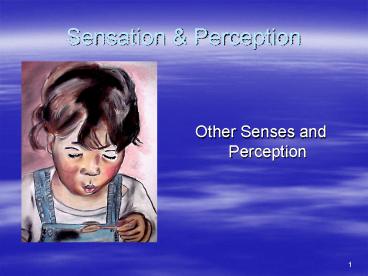Sensation - PowerPoint PPT Presentation
1 / 16
Title:
Sensation
Description:
Nerve impulses travel through the olfactory nerve to the olfactory bulb in the ... Food's flavor results from these combinations: aroma, texture, temperature ... – PowerPoint PPT presentation
Number of Views:28
Avg rating:3.0/5.0
Title: Sensation
1
Sensation Perception
Other Senses and Perception
2
Smell and Taste
- The chemical senses
- Nerve impulses travel through the olfactory nerve
to the olfactory bulb in the brain, causing
sensation of specific odors
3
The Olfactory Bulb
- Located in the front of the brain above the
nostrils - Olfactory cortex is located in the temporal lobe
- Connections to the limbic system
4
Taste
- Four basic tastes sweet, sour, salty, bitter
- Foods flavor results from these combinations
aroma, texture, temperature - Taste cells, taste buds
- Release neurotransmitters
5
Supertasters
- People who have greater taste sensibilities than
others - Supertasters have two to three times more taste
buds than normal
6
Kinesthetic
- Kinesthetic speed and direction of movement
- Vestibular sense movement and position of ones
body - Semicircular canals Speed and direction of body
rotation - Vestibular sacs Horizontal and vertical movements
7
Skin
- The skin is the largest sensory organ
- Touch, pressure, warmth, cold, pain
- 1.5 million receptors for touch and pressure,
somatosensory cortex
8
Pathways for Pain Signals
- Receptors send pain signals to the brain along
two pathways - Gate control mechanism incoming pain sensations
must pass through a gate in the spinal cord that
can be open or closed - Endorphins, acupuncture
9
Perception
10
Defining Perception
- An active process
- The brain pieces together bits of sensory
information in order to form orderly impressions
or pictures - Gestalt
- Whole, form, pattern
11
Gestalt Principle 1 Proximity
- Meaningful wholes seem to precede parts and
properties, as the Gestalt psychologists
emphasized years ago. Anne Triesman - Closeness of objects makes us view them as a group
12
Gestalt Principle 2 Similarity
- When similar and dissimilar objects are mingled
together, we see the similar objects as groups
13
Gestalt Principle 3 Continuity
- We tend to see continuous patterns, not disrupted
ones
14
Gestalt Principle 4 Simplicity
- We perceive the simplest shapes possible
15
Gestalt Principle 5 Closure
- Occurs when people see a familiar pattern or
shape with some missing parts
16
Perceptual Interference
- Perceptions are not always based on sensory
information - Perceptual interference occurs when we fill in
the gaps in what our senses tell us































